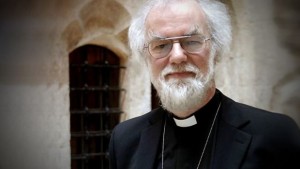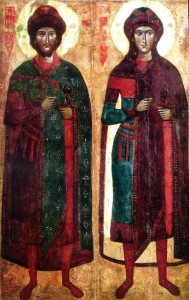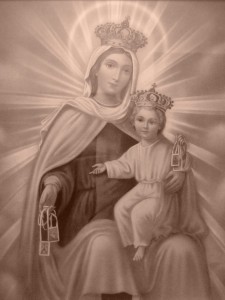 Today, the Church honors the Mother of God under the title of Our Lady of Mount Carmel. This feast, historically, is clearly a feast recognizing Mary’s patronage of the Carmelite order. What does this feast say to us today? The Marian feast of Carmel is pointing us to Mary’s interior life, her life of prayer –her contemplation by holding all things concerning her Son in her heart. The Church gives witness that all Christians are called to pray and to enter into contemplation according to the grace given by God.
Today, the Church honors the Mother of God under the title of Our Lady of Mount Carmel. This feast, historically, is clearly a feast recognizing Mary’s patronage of the Carmelite order. What does this feast say to us today? The Marian feast of Carmel is pointing us to Mary’s interior life, her life of prayer –her contemplation by holding all things concerning her Son in her heart. The Church gives witness that all Christians are called to pray and to enter into contemplation according to the grace given by God.
Only later did the feast get connected with the giving of the brown scapular to Saint Simon Stock for the members of the order, and later to the laity. According to Stock’s vision of Mary, in use of the brown scapular Mary there’s the promise to the wearer that she will intercede with her Son to have mercy at the time of death. The scapular is the outward sign (a sacramental) of the consecration one makes to the Blessed Virgin who leads the person to the Savior.
The Congregation of Divine Worship (at the Holy See) said in 1996, “Devotion to Our Lady of Mount Carmel is bound to the history and spiritual values of the Order of the Brothers of the Blessed Virgin Mary of Mount Carmel and is expressed through the scapular. Thus, whoever receives the scapular becomes a member of the order and pledges him/herself to live according to its spirituality in accordance with the characteristics of his/her state in life.”
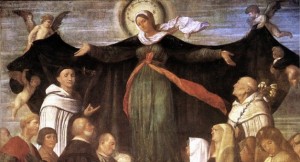 Discalced Carmelite Father Kieran Kavanaugh, said,
Discalced Carmelite Father Kieran Kavanaugh, said,
“The scapular is a Marian habit or garment. It is both a sign and pledge. A sign of belonging to Mary; a pledge of her motherly protection, not only in this life but after death. As a sign, it is a conventional sign signifying three elements strictly joined: first, belonging to a religious family particularly devoted to Mary, especially dear to Mary, the Carmelite Order; second, consecration to Mary, devotion to and trust in her Immaculate Heart; third an incitement to become like Mary by imitating her virtues, above all her humility, chastity, and spirit of prayer.”
As you know, all Marian theology points to Christ. Key in historical theology is the work of Saint Leo the Great who does not speak to the feast of Our Lady of Mount Carmel but he does contexutalize our teaching on Mary’s role in salvation history by making the crucial criterion of understanding her role viz. giving the Eternal Word, the Savior of All, human personhood.
Saint Leo is credited with forming the dogma of the Incarnation and taught by the weight of the argument and only then by his office the teachings of the Council of Chalcedon regarding the person of Jesus Christ: that Jesus has two natures—divine and human—united in one person, “with neither confusion nor division,” known in technical theological language as the hypostatic union.
What follows is a portion of a sermon by Saint Leo the Great, a Roman pope who reigned from 440 to 461; his feast day is November 10; the first to be called “Great.” Mary points to Christ, our Savior!!!
Mary conceived in her soul before she conceived in her body
A royal virgin of the house of David is chosen. She is to bear a holy child, one who is both God and man. She is to conceive him in her soul before she conceives him in her body. In the face of so unheard of an event she is to know no fear through ignorance of the divine plan; the angel tells her what is to be accomplished in her by the Holy Spirit. She believes that there will be no loss of virginity, she who is soon to be the mother of God. Why should she lose heart at this new form of conceiving when she has been promised that it will be effected through the power of the Most High? She believes, and her faith is confirmed by the witness of a previous wonder: against all expectation Elizabeth is made fruitful. God has enabled a barren woman to be with child; he must be believed when he makes the same promise to a virgin.
The son of God who was in the beginning with God, through whom all things were made, without whom nothing was made, became man to free him from eternal death. He stooped down to take up our lowliness without loss to his own glory. He remained what he was; he took up what he was not. He wanted to join the very nature of a servant to that nature in which he is equal to God the Father. He wanted to unite both natures in an alliance so wonderful that the glory of the greater would not annihilate the lesser, nor the taking up of the lower diminish the greatness of the higher.
What belongs to each nature is preserved intact and meets the other in one person: lowliness is taken up by greatness, weakness by power, mortality by eternity. To pay the debt of our human condition, a nature incapable of suffering is united to a nature capable of suffering, and true God and true man are forged into the unity that is the Lord. This was done to make possible the kind of remedy that fitted our human need: one and the same mediator between God and men able to die because of one nature, able to rise again because of the other. It was fitting, therefore, that the birth which brings salvation brought no corruption to virginal integrity; the bringing forth of Truth was at the same time the safeguarding of virginity.
Dearly beloved, this kind of birth was fitting for Christ, the power and the wisdom of God: a birth in which he was one with us in our human nature but far above us in his divinity. If he were not true God, he would not be able to bring us healing; if he were not true man, he would not be able to give us an example.
And so at the birth of our Lord, the angels sing in joy: Glory to God in the highest, and they proclaim peace to his people on earth as they see the heavenly Jerusalem being built from all the nations of the world. If the angels on high are so exultant at this marvelous work of God’s goodness, what joy should it not bring to the lowly hearts of men?
(Sermo 1 in Nativitate Domini, 2.3: PL 54, 191-192)
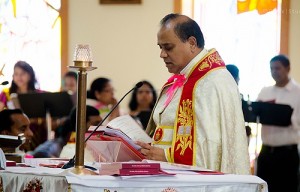 I awoke today to read that His Holiness, Pope Francis, nominated a friend and former colleague to be an auxiliary bishop for the Syro-Malabarese Eparchy of Saint Thomas the Apostle of Chicago. Father Joy Alappat, 57, the current rector of Mar Thoma Sleeha Cathedral in Bellwood, IL, takes on a new ministry: the first auxiliary bishop for the Syro-Malabar Catholic Church in the USA.
I awoke today to read that His Holiness, Pope Francis, nominated a friend and former colleague to be an auxiliary bishop for the Syro-Malabarese Eparchy of Saint Thomas the Apostle of Chicago. Father Joy Alappat, 57, the current rector of Mar Thoma Sleeha Cathedral in Bellwood, IL, takes on a new ministry: the first auxiliary bishop for the Syro-Malabar Catholic Church in the USA.
